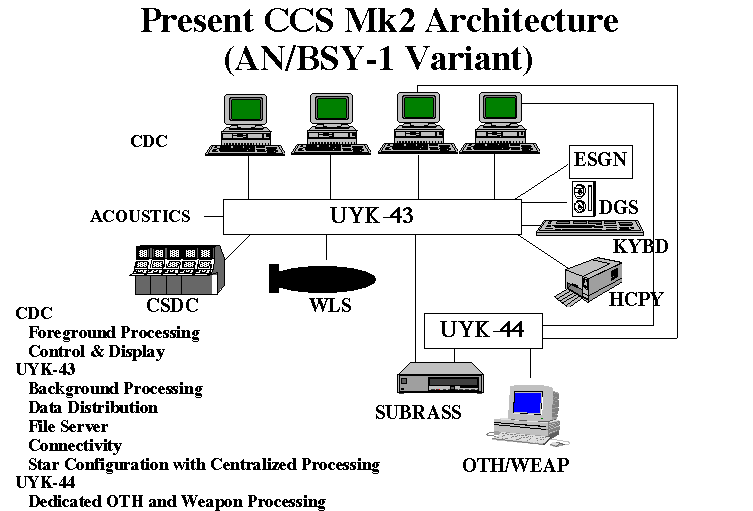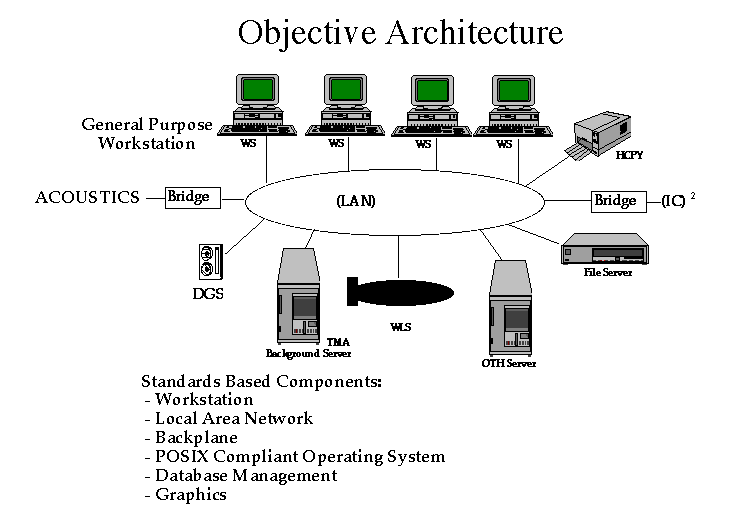


MK-2 Combat Control System
The AN/BQQ-5E sonar with the TB-29 towed array and Combat Control System (CCS) Mk 2, known collectively as the QE-2 System, provides a functionally equivalent system for the Los Angeles (SSN-688) and Ohio (SSBN-726)-class submarines. Enhancements include increases in acoustic performance, improved combat control capabilities and replacement of obsolete equipment. The Combat System (CCS) MK-2 will be installed in both Los Angeles (SSN) and Trident (SSBN) submarines. This system upgrade program will maximize functional commonality across platforms while enhancing performance and providing for system growth and flexibility.
The thrust of the submarine Combat Control System (CCS) Improvement program is the fleet introduction of submarine CCS MK2 Program D0 and the development of CCS MK2 Program D0 Blocks 1 and 2. CCS MK2 converged multiple submarine combat system developments into a single effort to minimize submarine life cycle costs, i.e., SSN 688, SSN 688I
and SSBN 726 Classes. With CCS MK 2, there will be a JMCIS Interface to the MK 2 Fire Control system. The organic contacts contained in the Fire Control System will be placed in the FCS area in JMCIS.
The CCS MK2 Block 1A/B program was initiated to provide an overall responsiveness to evolving fleet requirements. The primary objectives include:
- Greater commonality with surface ship combat systems
- Improved Tomahawk strike capability
- Incorporate planned updates to baseline program
- Conform to SECNAV initiatives for open architecture systems
To satisfy these objectives, the CCS MK2 Block 1 A/B system architecture extends the CCS MK2 tactical system with a network of Tactical Advanced Computers (TAC-3). These TAC-3s are configured to support the SFMPL, NTCS-A, LINK-11 and ATWCS subsystems. In order to provide the ability to control and configure TAC-3 system software and hardware a resource management function will be developed. Resource management is defined as the control, monitoring, and querying of both software and hardware resources, locally and remotely. Software resources will include CPU utilization, virtual memory, processes, and Inter-Process Communication (IPC). Hardware resources will include CPU, RAM, disk, I/O channels, and peripherals, in addition to network resources such as socket communication usage, availability, and load.
- CCS MK2 Program D0 provides a modular software
architecture, introduces Tomahawk Block 3 and Harpoon Block 1C
capabilities, introduces Advanced Capability (ADCAP) on TRIDENT, and
replaces obsolete equipment.
- CCS MK2 Program D0 Block 1 integrates CCS
MK2 into AN/BSY-1 systems, replaces additional obsolete equipment,
incorporates a direct interface to the Global Positioning System,
incorporates Joint Maritime Command Information System (JMCIS) into CCS
MK2, and implements Advanced Tomahawk Weapon Control System (ATWCS),
Tomahawk Block IV, ADCAP torpedo improvements and several other
miscellaneous enhancements. Navigation Sensor System Interface (NAVSSI)
provides real-time, accurate positional and velocity information for
distribution to Combat Control and other shipboard subsystems.
- CCS MK2 Program D0 Block 2 incorporates into submarine CCS anticipated upgrades to ADCAP, Tomahawk and Harpoon, and implements additional OER. AN/BSG-1 (formerly known as Tomahawk Land Attack Missile - Nuclear (TLAM-N) Portable Launching System (PLS)) provides SSN Submarines with a stand alone TLAM-N M issile launching capability.
The CCS MK2 Program D0 Block 1C program has been adjusted to maximize foreground software commonality with the NSSN Combat Control program. Due to changes in the TOMAHAWK Baseline Improvement Program (TBIP), OPNAV has directed TOMAHAWK Block IV missile capability be deferred and accomplished as an Engineering Change to the existing program baseline. TOMAHAWK Block IV capability has been deferred allowing for shortened and consolidated test events. The net result is a single Milestone III for all variants of CCS MK2 Block 1C by May 2000.


Sources and Resources
http://www.fas.org/man/dod-101/sys/ship/weaps/mk-2.htm
Maintained by Robert Sherman
Originally created by John Pike
Updated Saturday, December 12, 1998 7:17:49 AM






